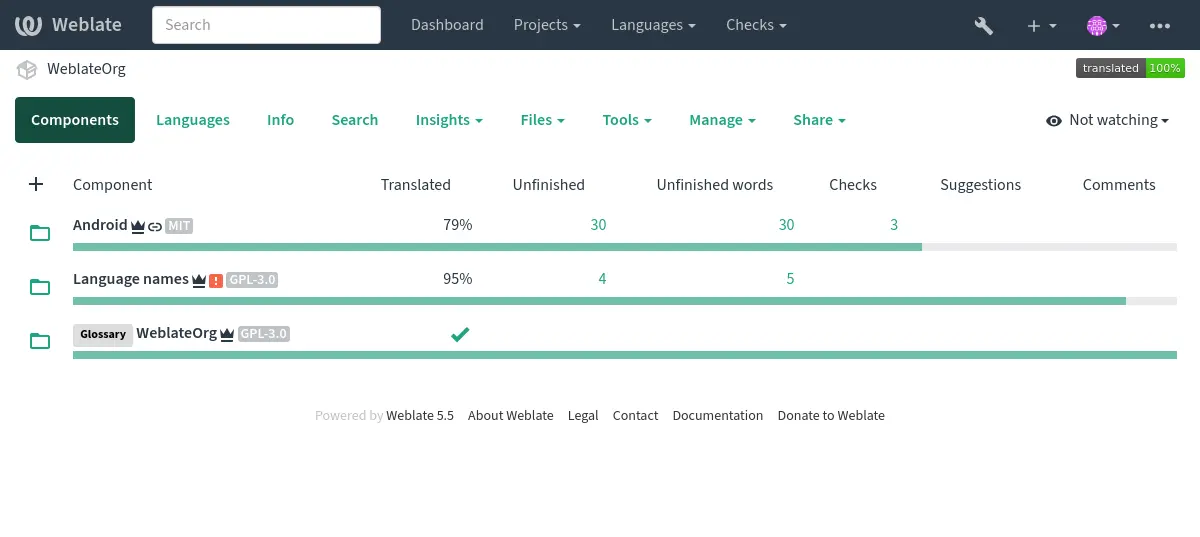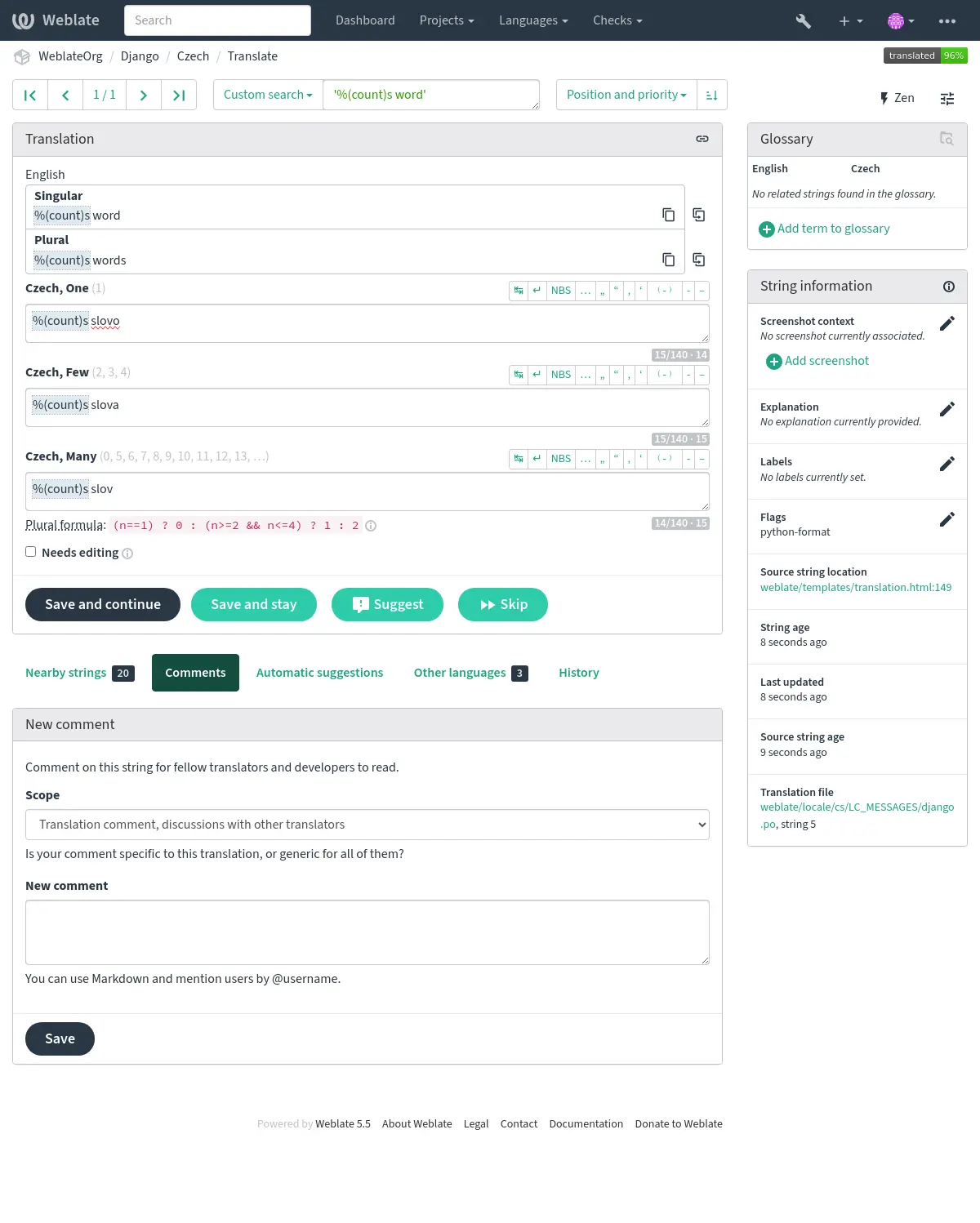Tłumaczenie za pomocą Weblate¶
Thank you for interest in translating using Weblate. Projects can either be set up for direct translation, or by way of accepting suggestions made by users without accounts.
Overall, there are two modes of translation:
The project accepts direct translations
The project only accepts suggestions, which are automatically validated once a defined number of votes is reached
Please see Proces tłumaczenia for more info on translation workflow.
Options for translation project visibility:
Widoczne publicznie
Visible only to a certain group of translators
Zobacz także
Projekty tłumaczeń¶
Translation projects hold related components; resources for the same software, book, or project.

Linki do tłumaczeń¶
Having navigated to a component, a set of links lead to its actual translation. The translation is further divided into individual checks, like Untranslated strings or Unfinished strings. If the whole project is translated, without error, All strings is still available. Alternatively you can use the search field to find a specific string or term.

Sugestie¶
Informacja
Actual permissions might vary depending on your Weblate configuration.
Anonymous users can only (by default) forward suggestions. Doing so is still available to signed-in users, in cases where uncertainty about the translation arises, prompting other translators to review it.
The suggestions are scanned on a daily basis to remove duplicates and suggestions matching the current translation.
Warianty¶
Variants are used to group different length variants of the string. The frontend of your project can then use different strings depending on the screen or window size.
Zobacz także
Etykiety¶
Labels are used to categorize strings within a project to further customize the localization workflow (for example to define categories of strings).
Następujące etykiety są używane przez Weblate:
- Przetłumaczono automatycznie
Ciąg został przetłumaczony przy użyciu Tłumaczenie automatyczne.
- Źródło wymaga przeglądu
Ciąg został oznaczony do przeglądu przy użyciu Recenzje ciągów źródłowych.
Zobacz także
Tłumaczenie¶
On the translation page, the source string and an editing area for its translation are shown. Should the translation be plural, multiple source strings and editing areas are shown, each described and labeled in the amount of plural forms the translated language has.
All special whitespace characters are underlined in red and indicated with grey symbols. More than one subsequent space is also underlined in red to alert the translator to a potential formatting issue.
Various bits of extra info can be shown on this page, most of which coming from the project source code (like context, comments or where the message is being used). Translation fields for any secondary languages translators select in the preferences will be shown (see Języki dodatkowe) above the source string.
Pod tłumaczeniem tłumacze znajdą sugestie innych osób do zaakceptowania (✓), zaakceptowania ze zmianami (✏️) lub usunięcia (🗑).
Liczba mnoga¶
Words changing form to account of their numeric designation are called plurals. Each language has its own definition of plurals. English, for example, supports one. In the singular definition of for example „car”, implicitly one car is referenced, in the plural definition, „cars” two or more cars are referenced (or the concept of cars as a noun). Languages like for example Czech or Arabic have more plurals and also their rules for plurals are different.
Weblate has full support for each of these forms, in each respective language (by translating every plural separately). The number of fields and how it is in turn used in the translated application or project depends on the configured plural formula. Weblate shows the basic info, and the Language Plural Rules by the Unicode Consortium is a more detailed description.
Zobacz także

Alternative translations¶
Added in version 4.13.
Informacja
This is currently only supported with Multivalue CSV file.
With some formats, it is possible to have more translations for a single string. You can add more alternative translations using the Tools menu. Any blank alternative translations will be automatically removed upon saving.
Skróty klawiaturowe¶
The following keyboard shortcuts can be utilized during translation:
Skróty klawiszowe |
Opis |
|---|---|
Alt+Home |
Przejdź do pierwszego tłumaczenia w bieżącym wyszukiwaniu. |
Alt+End |
Przejdź do ostatniego tłumaczenia w bieżącym wyszukiwaniu. |
Alt+PageUp lub Ctrl+↑ lub Alt+↑ lub Cmd+↑ |
Przejdź do poprzedniego tłumaczenia w bieżącym wyszukiwaniu. |
Alt+PageDown lub Ctrl+↓ lub Alt+↓ lub Cmd+↓ |
Przejdź do następnego tłumaczenia w bieżącym wyszukiwaniu. |
Ctrl+Enter lub Cmd+Enter |
Submit current form; this is same as pressing Save and continue while editing translation. |
Ctrl+Shift+Enter lub Cmd+Shift+Enter |
Usuń oznaczenie tłumaczenia jako wymagającego edycji i prześlij je. |
Alt+Enter lub Option+Enter |
Submit the string as a suggestion; this is same as pressing Suggest while editing translation. |
Ctrl+E lub Cmd+E |
Focus translation editor. |
Ctrl+U lub Cmd+U |
Focus comment editor. |
Ctrl+M lub Cmd+M |
Shows Automatic suggestions tab, see Automatyczne sugestie. |
Ctrl+1 do Ctrl+9 lub Cmd+1 to Cmd+9 |
Copies placeable of given number from source string. |
Ctrl+M followed by 1 to 9 or Cmd+M followed by 1 to 9 |
Copy the machine translation of given number to current translation. |
Ctrl+I followed by 1 to 9 or Cmd+I followed by 1 to 9 |
Zignoruj jedną pozycję na liście testów zakończonych niepowodzeniem. |
Ctrl+J lub Cmd+J |
Pokazuje kartę Ciągi sąsiadujące. |
Ctrl+S lub Cmd+S |
Focus search field. |
Ctrl+O lub Cmd+O |
Skopiuj ciąg źródłowy. |
Ctrl+Y lub Cmd+Y |
Przełącz pole wyboru Wymaga edycji. |
Klawiatura wizualna¶
A small visual keyboard row is shown just above the translation field. This can be useful to keep local punctuation in mind (as the row is local to each language), or have characters otherwise hard to type handy.
The shown symbols factor into three categories:
User configured Znaki specjalne defined in the Profil użytkownika
Per-language characters provided by Weblate (e.g. quotes or RTL specific characters)
Characters configured using
SPECIAL_CHARS

Kontekst tłumaczenia¶
This contextual description provides related info about the current string.
- Atrybuty ciągu
Things like message ID, context (
msgctxt) or location in source code.- Zrzuty ekranu
Screenshots can be uploaded to Weblate to better inform translators of where and how the string is used, see Kontekst wizualny dla ciągów.
- Ciągi sąsiadujące
Displays neighbouring messages from the translation file. These are usually also used in a similar context and prove useful in keeping the translation consistent.
- Inne wystąpienia
In case a message appears in multiple places (e.g. multiple components), this tab shows all of them if they are found to be inconsistent (see Niespójność). You can choose which one to use.
- Pamięć tłumaczeniowa
Look at similar strings translated in past, see Pamięć tłumaczeniowa.
- Słownik
Displays terms from the project glossary used in the current message.
- Ostatnie zmiany
List of people whom have changed this message recently using Weblate.
- Projekt
Project info like instructions for translators, or a directory or link to the string in the version control system repository the project uses.
If you want direct links, the translation format has to support it.
Historia tłumaczeń¶
Every change is by default (unless turned off in component settings) saved in the database, and can be reverted. Optionally one can still also revert anything in the underlying version control system.
Translated string length¶
Weblate can limit the length of a translation in several ways to ensure the translated string is not too long:
The default limitation for translation is ten times longer than the source string. This can be turned off by
LIMIT_TRANSLATION_LENGTH_BY_SOURCE_LENGTH. In case you are hitting this, it might be also caused by a monolingual translation erroneously set up as bilingual one, making Weblate mistaking the translation key for the actual source string. See Formaty dwujęzyczne i jednojęzyczne for more info.Maximal length in characters defined by translation file or flag, see Maksymalna długość tłumaczenia.
Maximal rendered size in pixels defined by flags, see Maksymalny rozmiar tłumaczenia.
Automatyczne sugestie¶
Based on configuration and your translated language, Weblate provides suggestions from several machine translation tools and Pamięć tłumaczeniowa. All machine translations are available in a single tab of each translation page.
You can also perform a concordance search on the Pamięć tłumaczeniowa.
Zobacz także
You can find the list of supported tools in Automatyczne sugestie.
Tłumaczenie automatyczne¶
You can use automatic translation to bootstrap translation based on external sources. This tool is called Automatic translation accessible in the Tools menu, once you have selected a component and a language:

Two modes of operation are possible:
Using other Weblate components as a source for translations.
Using selected machine translation services with translations above a certain quality threshold.
You can also choose which strings are to be auto-translated.
Ostrzeżenie
Be mindful that this will overwrite existing translations if employed with wide filters such as All strings.
Useful in several situations like consolidating translation between different components (for example the application and its website) or when bootstrapping a translation for a new component using existing translations (translation memory).
Automatycznie przetłumaczone ciągi są oznaczone jako Przetłumaczono automatycznie.
Ograniczenie szybkości¶
To avoid abuse of the interface, rate limiting is applied to several operations like searching, sending contact forms or translating. If affected by it, you are blocked for a certain period until you can perform the operation again.
Default limits and fine-tuning is described in the administrative manual, see Ograniczenie szybkości.
Wyszukaj i zamień¶
Change terminology effectively or perform bulk fixing of the strings using Search and replace in the Tools menu.
Podpowiedź
Nie martw się, że popsujesz ciągi znaków. Jest to dwuetapowy proces przedstawiający podgląd edytowanych ciągów przed potwierdzeniem rzeczywistej zmiany.
Edycja zbiorcza¶
Bulk editing allows performing one operation on number of strings. You define strings by searching for them and set up something to be done for matching ones. The following operations are supported:
Changing string state (for example to approve all unreviewed strings).
Adjust translation flags (see Dostosowywanie zachowania za pomocą flag)
Adjust string labels (see Etykiety ciągów)
Podpowiedź
This tool is called Bulk edit accessible in the Tools menu of each project, component or translation.
Zobacz także
Widok matrycy¶
To compare different languages efficiently you can use the matrix view. It is available on every component page under the Tools menu. First select all languages you want to compare and confirm your selection, after that you can click on any translation to open and edit it quickly.
The matrix view is also a very good starting point to find missing translations in different languages and quickly add them from one view.
Tryb zen¶
The Zen editor can be enabled by clicking the Zen button on the top right while translating a component. It simplifies the layout and removes additional UI elements such as Nearby strings or the Glossary.
You can select the Zen editor as your default editor using the Preferencje tab on your Profil użytkownika. Here you can also choose between having translations listed Top to bottom or Side by side depending on your personal preference.
Komentarze¶
Three types of comments can be posted: for translations, source strings, or to report source string bugs when this functionality is turned on using Włącz przeglądy źródeł. Choose the one suitable to topic you want to discuss. Source string comments are in any event good for providing feedback on the original string, for example that it should be rephrased or to ask questions about it.
Możesz używać składni Markdown we wszystkich komentarzach i wspominać innych użytkowników za pomocą
@wspomnienie.Zobacz także
Otrzymywanie informacji zwrotnej o ciągu źródłowym, Recenzje ciągów źródłowych, Włącz przeglądy źródeł